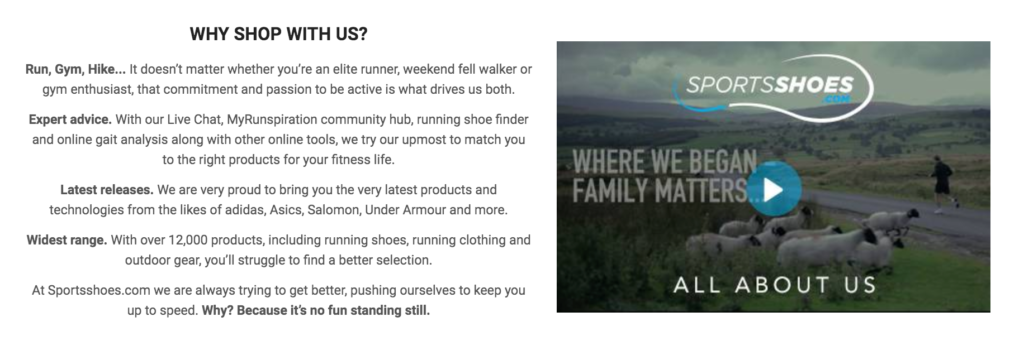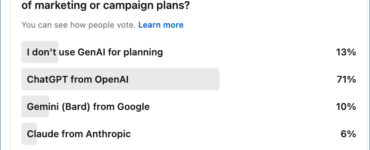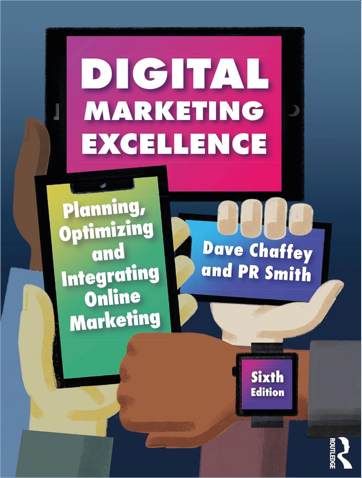Making your marketing more customer-centric using the 6Cs of digital marketing
I have recommended creating an Online Value Proposition (OVP) in my books for many years. Today, it’s perhaps best called a digital value proposition (DVP).
If organisations want to maximise usage of online channels , my view is that a distinct, detailed online value proposition (OVP) must be developed for the target audiences. The watch word here is distinct – the online proposition should not simply replicate the existing service proposition or brand promise that it is available from offline channels, but it should extend it to offer unique online benefits.
Contrast this with the approach many companies have taken which is simply to transfer their existing proposition to the online environment. The worst manifestation of this is the simple ‘brochureware’ sites which offer little more than an introduction to “who we are, what we do and where to find us” or sometimes simply “these are our products – take them or leave them”. This approach fails to take advantage of the unique properties of the online media such as its immediacy, interactivity and depth of content that is only limited by imagination and resource.
Once an OVP has been defined, then e-marketers then need to work hard to clearly communicate this proposition online and offline. Furthermore, as for any proposition, they need to evaluate how well it resonates with its audiences and revise it accordingly. So, part of proposition development is the identification of powerful messages to convey the proposition. Using both offline and offline communications to build usage of online channels will be ineffectual if the messaging is the all-too-common “Visit our web site @ www.company.com” or “Sign-up for our e-newsletter”!
Some practical examples of online value propositions
In this retail e-commerce online value proposition case study, they highlight their commitment to content investment and developing an OVP when they say:
“We are proud to share the most comprehensive, most detailed product knowledge in the industry with you – and from video guides to live expert advice, we’re here to help you to make the most informed choices possible”.
The OVP is also highlighted on the home page with the differentiating Why Shop With Us message:

Within their home page different forms of content supporting the OVP are shown in this panel:

Content they have developed to emphasize their OVP includes:
- Community – Running Hubs with blogs and discussion
- Tools – Product finder tools and running analysis tools
- Buyers’s guides – recommendations for buying a particular types of tool
- Run of site featuring of content – either in a header or in a footer on every page.
The OVP is also evident on individual product pages through more detailed content and product videos.
What is a customer value proposition?
Development of a clear customer value proposition is now an integral part of customer-centric marketing, customer-relationship management and branding. A conventional view of the value proposition is provided by Knox et al. (2003) in their review of approaches to customer relationship management. They say a value proposition is:
“an offer defined in terms of the target customers, the benefits offered to these customers, and the price charged relative to the competition.”
Similarly, Rayport and Jaworski (2004) suggest that construction of a value proposition requires consideration of (1) Target segments, (2) Focal customer benefits, (3) Resources to deliver the benefits package in a superior manner to competitors. However, branding advocates believe that the value proposition is more than the sum of product features, prices and benefits. They argue that it also encompasses the totality of the experience that the customer has when selecting, purchasing and using the product. We will see that these customer experiences and also service quality are very important online. For example, Molineux (2002) states that:
“the value proposition describes the total customer experience with the firm and in its alliance partners over time, rather than [being limited to] that communicated at the point of sale”.
Similarly, Smith and Wheeler (2002) consider that designing what they refer to as a ‘branded customer experience’ is vital to delivering an effective value proposition. They also stress the importance of “developing a profound understanding of the customer’s experience”. The watch word here is profound – they suggest that detailed research must determine the nature of value which drive buying and loyalty behaviour:
From this rapid review of the fundamentals of customer value propositions, we can summarise the following success factors for developing an effective online value proposition:
- The offer forming the OVP is developed specifically for different target customer segments.
- The OVP is not limited to the customer experience on-site but involves how it links to other channels as part of a multi-channel buying process
- The product or service offer and experience that form the OVP must be based on in-depth research of which factors govern purchase and loyalty behaviour and refined according to actual experience of the OVP by customers.
What is an online value proposition?
From our review of the essence of customer value propositions, we can suggest that the issues to be considered when formulating an online value proposition should include:
- Identification of a clear differentiation of the online proposition compared to the companies conventional offline proposition, i.e. to extend the offline proposition.
- Identification of a clear differentiation of the online proposition from competitors based on cost, product innovation or service quality.
- Target market segment(s) that the proposition will appeal to.
- How the proposition will be communicated to site visitors and in all marketing communications. Developing a strap line can help this; we will look at some examples shortly.
- How the proposition will be delivered across different parts of the buying process, i.e. it should not just refer to the product itself, but also give an indication of the pre-sales and post-sales support that can be provided by the online service.
- How the proposition will be delivered and supported by resources – is the proposition genuine? Will resources be internal or external?
To summarise, the ‘Online Value Proposition’ or OVP should:
- Reinforces core brand proposition and credibility, but also shows:
- What can a visitor get from your online services that…
- They can’t get from you offline?
- They can’t get from competitors?
- What can a visitor get from your online services that…
Benefits of an online value proposition
Varianini and Vaturi (2000) conducted a review of failures in B2C dot-com retailers in order to highlight lessons that can be learned. They believe that many of the problems have resulted from a failure to apply established marketing orientation approaches including definition and communication of a clear value proposition. They summarise their guidelines as follows:
“First identify customer needs and define a distinctive value proposition that will meet them, at a profit. The value proposition must then be delivered through the right product and service and the right channels and it must be communicated consistently. The ultimate aim is to build a strong, long-lasting brand that delivers value to the company marketing it”.
Similarly, Agrawal et al. (2001) suggest that the success of leading e-commerce companies is often due to matching value propositions to segments successfully.
Having a clear online value proposition has several benefits:
- it helps distinguish an e-commerce site from its competitors (this should be a web site design objective);
- it helps provide a focus to marketing efforts and enables company staff to be clear about the purpose of the site;
- if the proposition is clear it can be used for PR and word-of-mouth recommendations may be made about the company. For example, the clear proposition of Amazon on its site is that prices are reduced by up to 40 per cent and that a wide range of three million titles is available;
- it can be linked to the normal product propositions of a company or its product.
A further practical reason for developing an OVP is that customers expect it! Research reported by Jakob Nielsen shows that new visitors to a site, particularly of a company they are unfamiliar with, will seek out a tagline or graphic that explains what the site can offer (WIFM – or What’s in It For Me). Users decide quickly (often within a few seconds whether to stay or leave a site and the tagline is a large part of this).
Formulating an OVP
It follows from our exploration of what comprises a value proposition, that to create a successful online value proposition, marketers must understand specific characteristics of online channels and the benefits they offer to customers. To help formulate the OVP we need to consider the special characteristics of the Internet and its online services as perceived by customers using them. A simple mnemonic is provided by these “Six C s” which have been used in varying combinations since the Internet has become a channel to market.:
- Content – In the beginning it was said that ‘Content is King’. Well content is still King, it’s just that I don’t think enough attention is given to precisely which ‘Content is King’. To my mind, regal content is rich, which means it provides something that other channels can’t. Often this means more detailed, in-depth information to support the buying process or product usage. However, often online product catalogues simply replicate what is in offline catalogues without adding extra information, images or example applications. Messaging through E-mail, SMS and RSS is also key to providing unique content – these media can be used to deliver timely, relevant media to individuals.As well as text-based content which is king for business-to-business there is also interactive content which is king for consumer sites and particularly brands. Consumer FMCG brands now use the web to deliver what they term as ‘Digital assets’ which support offline branding campaign. Connections to content on other sites is important for many sites since links to relevant resources on other destination sites can improve the customer experience on the referring (original site).
- Customisation – In this case mass customisation of content whether received as web site pages or e-mail alerts and commonly known as personalisation. Of course, Amazon is quoted ad-nauseum as an example of this, but did you know that they see it as so important, they actually have a “Director of Personalisation”. In addition to the standard “customers who bought this product also bought that product” approach Amazon also automates the creation of standard messages on-screen delivered in different slots or portlets, E-mail messages and Search engine adverts. The ability for a subscriber to an online e-mail service to tailor their messages by selectively opting-in to particular types of message is a further example of customisation.
- Community – Last and probably least is Community, these days known as ‘social networks’. Online channels such as the Internet are known as ‘many-to-many’ media meaning that your audiences can contribute to the content. For consumer retail, review sites are important to informing customer perceptions of brands. Similarly in business markets some specialist communities have been set up. However such community services are typically independent from suppliers of products and services and it is more difficult to build in these services into product supplier sites since comments made by customers may damage the brand. Supplier community sites were in vogue around 2000 at the time the Cluetrain manifesto (www.cluetrain.net) was launched with companies such as Egg with their Egg Free Zone and Symantec with sharing customer queries and solutions. However, such communities services have now been closed down, presumably because of the difficulty in controlling the negative perceptions they can engender.
- Convenience – This is the ability to select, purchase and in some cases use products, from your desktop at any time; the classic 24 X 7 X 365 availability of a service. Online usage of products is, of course restricted to digital products such as music or other data services. Amazon has advertised offline using creative showing a christmas shopper battling against a gale swept street clutching several bags to reinforce the convenience message.
- Choice – The web gives a wider choice of products and suppliers than via conventional distribution channels. The success of online intermediaries is evidence of this. Similarly Tesco.com provided Tesco with a platform to give consumers a wider choice of products (financial, travel, white goods) with more detailed information than is physically available in store.
- Cost reduction – The Internet is widely perceived as a relatively low-cost place of purchase. Similarly, a key component of the easyJet OVP when it launched was single tickets that were £2.50 cheaper than phone bookings. This simple price differential together with the limited change behaviour required from phone booking to online booking has been a key factor in the easyJet online ticketing channel effectively replacing all other booking modes.
Note, the 7Cs of Rayport and Jaworki (2003) provides a similar framework of Context, Content, Community, Customisation, Communication, Connection and Commerce.
At alternative, more classical method of reviewing how the proposition can be extended online is to consider how the marketing mix can be varied online. For example in the content of the above list:
-
- Product (Content, Customisation, Community) – Providing new digital services via web sites and e-mail to extend or tailor the product.
- Price (Cost reduction) – Offering differential prices – typically lower online, but maybe higher if the Convenience and Content factors are favourable. For example, the London Eye now offers a 5% discount for online booking, but in the past it has charged a premium since it was more convenient than phone.
- Place – Online provides a new place and a new channel – simple!
- Promotion – in addition to providing a number of new methods for customer acquisition through search engines, affiliates and e-mail for example, the web is at its best when Unique web offers are available in the form of competitions and sales promotion.
- Physical evidence, People, Process (Providing new forms of customer service such as the in-depth frequently asked questions database at www.easyjet.com). These elements of the mix are very important to the overall experience. Indeed Jeff Bezos of Amazon has said (quoted by Smith and Wheeler (2002) that ““Customer service is a critical success factor in any retail business, but it’s absolutely critical online”Fulfillment is critical for online retail sites, but for all sites there are other aspects of customer service that are important to all companies with an online presence – not just retailers. These include response times to e-mail or phone enquires and the availability (percentage of time site is up and running) and download performance of sites. It often seems as if sometimes these parts of the experience are underestimated. Services show that there is a large variance between the fastest and the slowest sites, but users will tend to compare their satisfaction with their current site against the fastest.
References
Agrawal, V., Arjona, V. and Lemmens, R. (2001) E-performance: the path to rational exuberance. Mckinsey Quarterly, No 1. 31-43.
van Duyne, D., Landay, J. Hong, J. (2001) The Design of Sites. Patterns, Principles, and Processes for Crafting a Customer-Centered Web Experience. Addison-Wesley, Reading, MA.
Knox, S., Maklan, S., Payne, A., Peppard, J. and Ryals, L. (2003) Customer Relationship Management: Perspectives from the Marketplace. Butterworth Heineman, Oxford, UK.
Molineux, P. (2002) Exploiting CRM. Connecting with customers. Hodder & Stoughton, London, UK.
Nielsen (2001) Tagline Blues: What’s the Site About? Alertbox, July 22, 2001
Rayport, J. and Jaworski, B. (2004) Introduction to E-commerce. McGraw-Hill, NY, NY. 2nd edition.
Seybold, P. (2001) Get inside the lives of your customers. Harvard Business Review. May 2001, pp80-89.
Smith, S. and Wheeler, J. (2002) Managing the Customer Experience. FT-Prentice Hall. Harlow, UK.
Varianini, V. and Vaturi, D. (2000) Marketing lessons from e-failures. McKinsey Quarterly, No 4. pp86-97.






